The state of Michigan is infamous for its miserable winters and frequent tornadoes. Temperatures in the region can plummet to about 27 °F (-3 °C) during the winter season. With temperatures this low, Michigan can seem like an unlikely place for birds to thrive. In reality though, Michigan is usually teeming with birds in the winter.
The state, which has more than 3000 miles of the Great Lakes, coastline is home to more than 400 species of birds. Many of these bird species stick around in winter, while few others regularly show up from the north. Dark-eyed juncos, snow buntings, horned larks, boreal owls, and blue jays are just a few of the magical birds that find their way down to the state. In this article, we will look at 20 birds that are commonly spotted in Michigan in the winter. However, before we do that, let’s find out why some of these birds arrive or stick around in the region even in cold weather.
Why Do Some Birds Stay for Winter and How Do They Survive?
Not all birds migrate away from the chilly weather of Michigan! Why, you may ask? Because some birds have reliable food sources all year long. Migration in birds is largely triggered by diminishing food reserves. Some birds can, however, just alter their eating habits for wintertime survival. So, birds that usually eat worms and berries, may start to eat twigs or nuts for their sustenance instead.
Many birds can also adapt to the bitter cold weather in Michigan by fluffing their feathers. Feathers act as excellent insulation; by puffing them up, these birds can trap body heat. Shivering is another one of the many adaptations that birds have developed to help them stay warm. Apart from that, smaller birds often huddle up or try to find refuge in tree hollows or dense foliage during the colder season.
So now, let’s take a look at Michigan’s top 20 winter birds.
1. Red Crossbill

The red crossbill has a very unique beak, which allows it to open sources of food easily.
©iStock.com/bobloblaw
- Appearance and Size: The red crossbill (Loxia curvirostra) is a stubby, medium-sized songbird with a crisscrossed bill and a short, notched tail. Adult males are brick red or orange, with darker brownish-red wings and tails. Females are more olive-brown and have a streaked yellowish chest. Immatures are brown with a streaked, whitish chest.
- Habitat: They are found in mature coniferous forests and groves, particularly spruce and pine
- Diet: Mostly seeds of conifers and pines
- Status in Michigan: These birds can be seen year-round in the northernmost parts of the state. In the other parts of the state, however, the red crossbill becomes more visible during the winter months.
- Cool Fact: The biting muscles of a red crossbill are stronger than the muscles that help its bill open, allowing it to crack and eat a wide variety of seeds.
2. Boreal Owl

The boreal owl is a sit-and-wait predator that captures its prey by stealth rather than strength or speed!
©WildMedia/Shutterstock.com
- Appearance and Size: The boreal owl (Aegolius funereus) is a small owl with bright eyes and a large square head. Females usually weigh around 4.6-6.3 oz. and are heavier than their male counterparts who weigh around 3.8 oz. on average. The bird is brown overall with white spots on the back and brown markings on the white underparts. Juveniles have no markings or spots.
- Habitat: Aspen, poplar, birch, fir, and spruce-dominated forests across northern North America and much of Eurasia.
- Diet: Insects, birds, and small mammals like mice, squirrels and shrews.
- Status in Michigan: Typically found in Michigan’s eastern upper peninsula in the winter.
- Cool Fact: The ears of the boreal owl are asymmetrical in their positioning, with the left ear positioned lower than the right one. The different positions of the ear openings help the owl identify the distance and direction of a sound.
3. Snowy Owl

The snowy owl is the largest North American owl by weight
©Carol Gray/iStock via Getty Images
- Appearance and size: The snowy owl (Bubo scandiacus) is a large, hefty owl weighing between 40 and 70 ounces. Adult males are pure white with a distinctive round head and piercing yellow eyes. Adult females and immatures are white with darker markings throughout their body and plumage.
- Habitat: The Arctic Tundra where trees are sparse or wide-open spaces
- Diet: Snowy owls are primarily carnivores and feed on small mammals and birds including lemmings, rabbits, squirrels, grebes, ducks, seabirds, and geese, among others.
- Status in Michigan: They are usually spotted in the Upper and Northern Lower Peninsulas of the state during the winter months. However, during some years, the snowy owl may also make a rare appearance in the southern regions of the state.
- Cool Fact: The feet of snowy owls are covered with feathers giving them the appearance of fluffy slippers.
4. Horned Lark

Sandy-brown horn larks are the only native larks in North America!
©mirceax/iStock via Getty Images
- Appearance and size: The horned lark (Eremophila alpestris) or shore lark is a small, tan-black bird that weighs around 1.0-1.7oz and is 6-8 inches in length. It has a black tail, black stripes across its face and throat, yellow or white eyebrows, ears and chin, and tufts of feathers that look like horns on its head. Females and males look almost alike, although female horned larks are a little duller in color.
- Habitat: They are commonly spotted in open areas and areas with short grass including lawns, prairies, fields, and sometimes even in airports and along lake shores.
- Diet: Small seeds and occasionally insects, berries, and snails
- Status in Michigan: Horned larks are year-round residents in Southern Michigan.
- Cool Fact: When a male horned lark is ready to mate, it sings to the female while hovering above her in circles.
5. Snow Bunting

The female has less vibrant coloration than the male, giving it extra protection while nesting.
©xpixel/Shutterstock.com
- Appearance and size: The snow bunting (Plectrophenax nivalis) is a rusty white, small to medium-sized bird with white and black wingtips.
- Habitat: Arctic tundra or open areas including grasslands and coastal areas.
- Diet: The snow bunting feeds on a mixed diet of seeds, buds, and invertebrates. During the breeding season, its diet mainly consists of grass and weed seeds.
- Status in Michigan: These birds can be found throughout the state in the winter and may be spotted in open grasslands, and farm fields, as well as along lake shores and the edges of rural roads.
- Cool Fact: Snow buntings are often called ‘snowflakes’, as flocks of snow buntings swirling through the air resemble snowflakes.
6. Dark-Eyed Junco
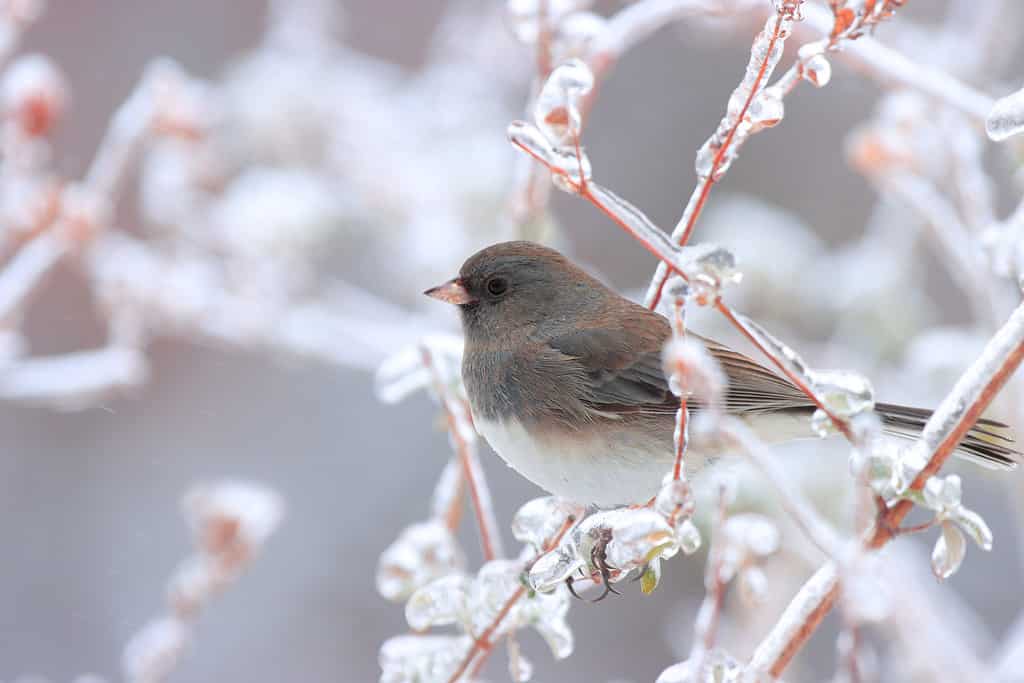
Dark-eyed juncos (
Junco hyemalis) are opportunistic feeders and can adapt their diet to the available food sources.
©Walter Coate/Shutterstock.com
- Appearance and size: These birds are medium-sized sparrows and have a rounded head, a long, conspicuous tail, and a short, conical bill. Juncos vary in color across regions but are largely dark brown or gray with a stout pink bill.
- Habitat: The habitat preferences of the dark-eyed junco vary from coniferous and mixed woodlands to fields, suburban backyards, and parks.
- Diet: Primarily grass and weed seeds, although they eat berries and insects such as caterpillars, weevils, ants, grasshoppers, and spiders as well.
- Status in Michigan: They are common winter visitors and can be found throughout the state.
- Cool Fact: Dark-eyed juncos are nicknamed ‘snowbirds’ because their arrival from northern breeding grounds seems to foretell the return of cold, snowy weather.
7. Red-Bellied Woodpecker
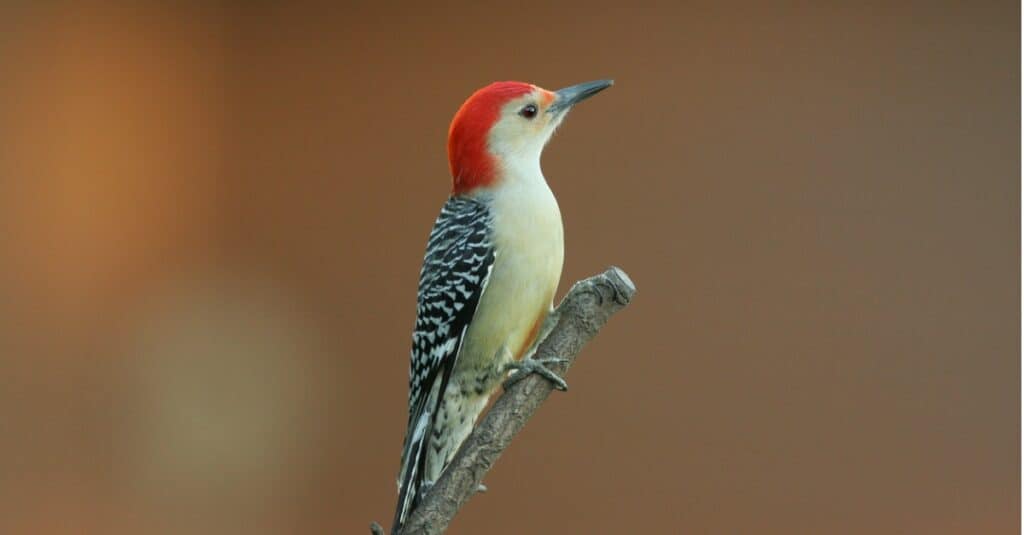
The red-bellied woodpecker, contrary to its name, has a bright red head and a fairly white belly!
©iStock.com/Flatcoater
- Appearance and size: The red-bellied woodpecker (Melanerpes carolinus) is a medium-sized bird that stands out for its distinctive black–and–white zebra barring and long, chisel-shaped bill. Males are typically larger than females and they weigh around 72.5 grams. While adult males sport full red foreheads, caps, and napes, the red cowl is limited to the back of the head in females.
- Habitat: Deciduous and occasionally groves, orchards, and towns.
- Diet: Eats berries, fruits, suet, sunflower seeds, nuts, tree sap, mice, salamanders, and even small nesting birds.
- Status in Michigan: Red-bellied woodpeckers are year-round residents in Michigan and can be found in woodland and suburban areas of the state.
- Cool Fact: These birds can stick their tongue out nearly 2 inches past the end of their beaks.
8. Hairy Woodpecker
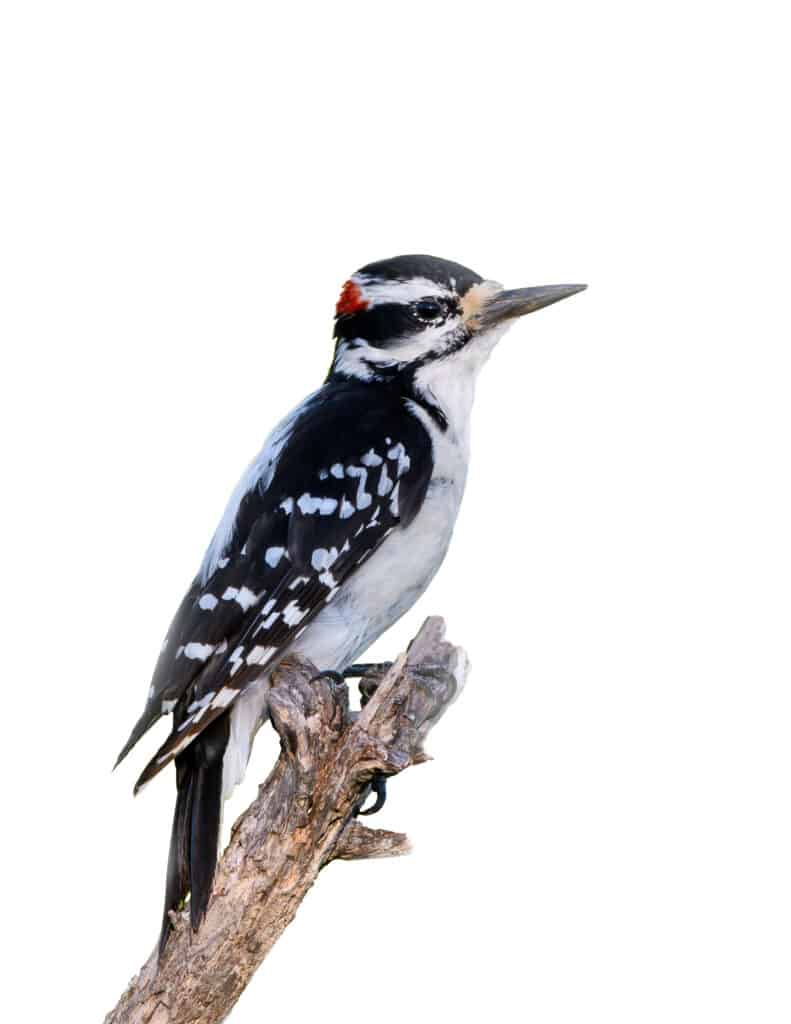
Male hairy woodpeckers can be distinguished by the red feathers on the back of their heads
©FotoRequest/Shutterstock.com
- Appearance and size: The hairy woodpecker (Dryobates villosus) is a powerful, medium-sized bird with a sturdy chisel-like beak. Females and males look alike with white bellies, black backs, and a central white stripe across their back and wings. Some adult males may, however, have a red patch on the back of their head.
- Habitat: Mature forests and large trees
- Diet: Fruits, seeds, nuts, suet, cracked corn, insects, ants, spiders and beetles.
- Status in Michigan: Hairy woodpeckers are widespread in Michigan and can be found in the state throughout the year.
- Cool Fact: The hairy woodpecker has earned its name for the long, hair-like white feathers on its back.
9. Downy Woodpecker

A beautiful male downy woodpecker searching through weeds for food!
©J Edwards Photography/Shutterstock.com
- Appearance and size: Downy woodpeckers (Picoides pubescens) are small woodpeckers with black-and-white plumage similar to that of the larger hairy woodpecker. Adult males have a red patch on the back of their heads.
- Habitat: Woodlands and forests are their most common habitats, although they are equally at home in backyards and parks.
- Diet: Insects, ants, spiders, nuts, suet, seeds, and fruits such as sumac and poison ivy.
- Status in Michigan: These birds are non-migratory residents and can be found throughout the state.
- Cool Fact: Downy woodpeckers are the smallest and most widespread woodpeckers in North America.
10. American Goldfinch

Winter birds are drab and unstreaked brown!
©iStock.com/Ronald Washington
- Appearance and size: The American goldfinch (Spinus tristis) is a small finch that only weighs around 0.39-0.71 oz. It has long wings, a short tail, and a short bill. Adult males are a bright canary-yellow with a black forehead and black plumage with white markings. Adult females have duller yellow underparts and are olive-brown above. In winter, these birds lose most of their color, giving way to drab, brown plumage.
- Habitat: Typically reside in weedy fields, brushy woodland edges, meadows, and open habitats
- Diet: Goldfinches are primarily seedeaters and consume a variety of weed, grass, and plant seeds.
- Status in Michigan: These birds are common year-round residents in the state.
- Cool Fact: The American goldfinch is the state bird of Iowa, New Jersey, and Washington.
11. Blue Jay

Noisy calls and the blue, black, and white plumage are the telltale signs of a blue jay.
©Matthew Jolley/Shutterstock.com
- Appearance and size: Blue jays (Cyanocitta cristata) are large songbirds that measure 10-12 inches approximately. It has a perky crest and bright blue mantle with intricate patterns of blue, white, and black on its wings. Males are slightly larger than females.
- Habitat: Oak and pine woods, groves, towns and suburban areas
- Diet: Nuts, seeds, insects, grains, fruits, and sometimes small vertebrates
- Status in Michigan: These birds are common and year-round residents throughout the state.
- Cool Fact: Blue jays aren’t really blue; the pigment in their feathers is actually brown.
12. Black-Capped Chickadee
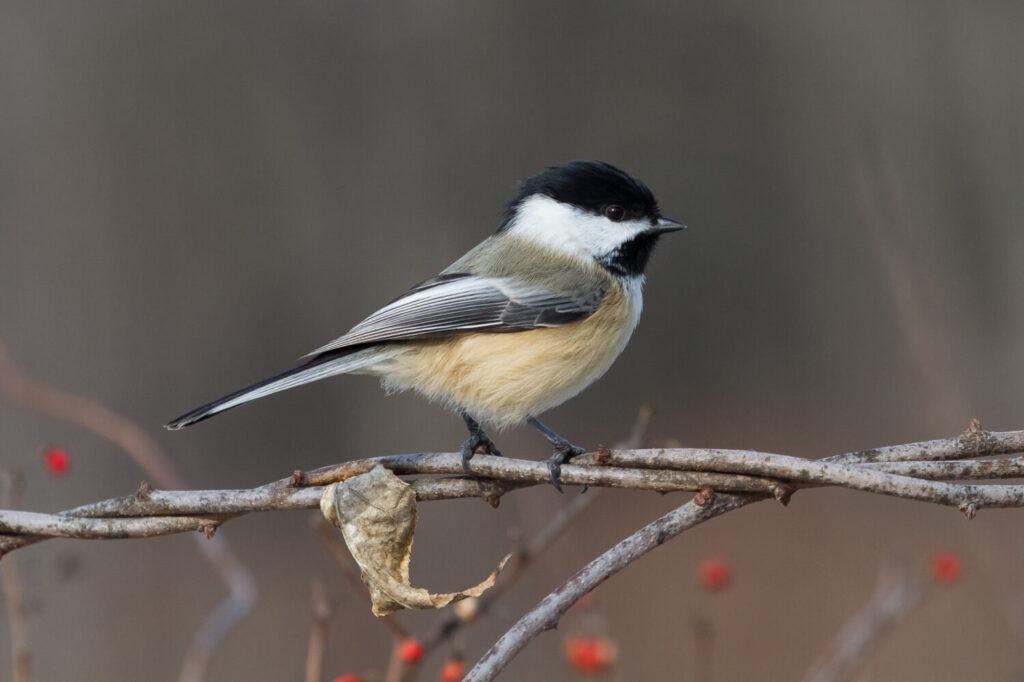
Black-capped chickadees are one of the most beloved birds in Michigan!
©Paul Roedding/Shutterstock.com
- Appearance and size: Black-capped chickadees (Poecile atricapillus) are small birds weighing only about 03-0.5 oz. They have oversized round heads and tiny bodies with black-feathered caps and throat patches, a buff-colored belly, and white cheek feathers.
- Habitat: Mixed and deciduous woods, groves, willow thickets and shade trees
- Diet: They are omnivores and feed on seeds, berries, and small fruits as well as insects, spiders, snails, and other invertebrates.
- Status in Michigan: They are common year-round residents found throughout Michigan
- Cool Fact: Black-capped chickadees have amazing memories. They often cache or hide food in a dozen different places and are able to relocate it later.
13. Northern Cardinal
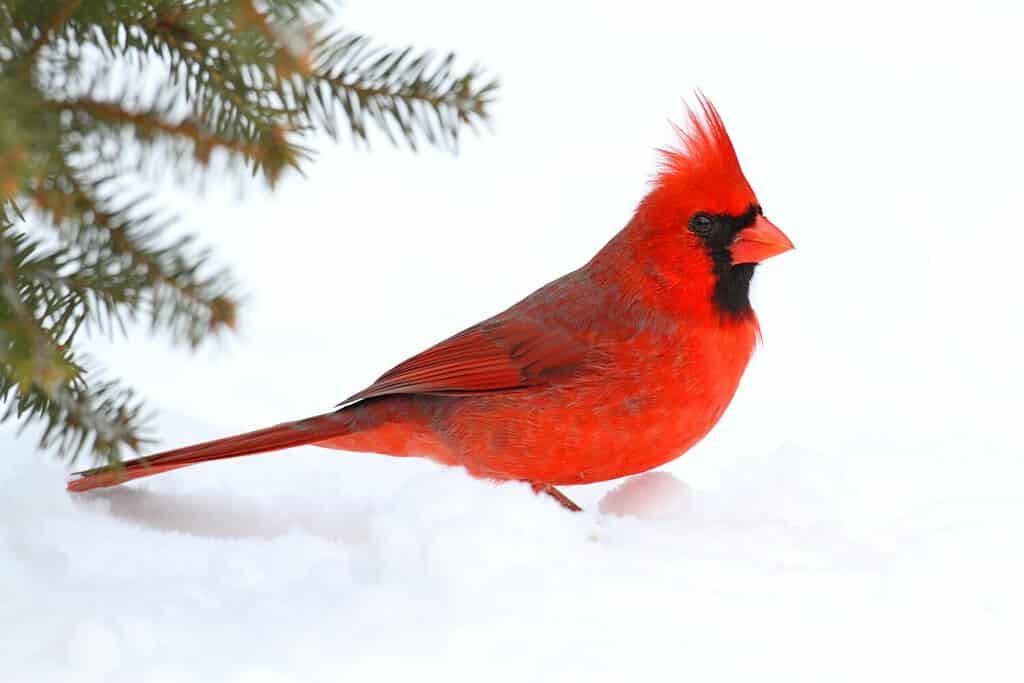
This brilliant red bird can brighten any dreary winter day!
©Steve Byland/Shutterstock.com
- Appearance and size: Northern cardinals (Cardinalis cardinalis) are fairly large birds and measure about 7 to 9 inches in length. They have a long tail, a very thick bill, and a sharp crest of feathers on the top of their head. Males sport a bright red plumage and have a black face. Females, on the other hand, are a muted brownish-red version of the males.
- Habitat: Backyards, parks, shrubby forest edges, woodlots and residential areas
- Diet: Their primary diet consists of insects, buds, berries, and seeds, although in winter they may rely more on nuts, seeds, and wild fruits.
- Status in Michigan: They are non-migratory residents in Michigan and are usually seen in plenty in the southern Lower Peninsula and sometimes in the northern Lower Peninsula. They are, however, scarce in the Upper Peninsula.
- Cool Fact: Northern cardinals have a unique courtship ritual in which male cardinals feed a bit of food to the female they are wooing.
14. Tufted Titmouse
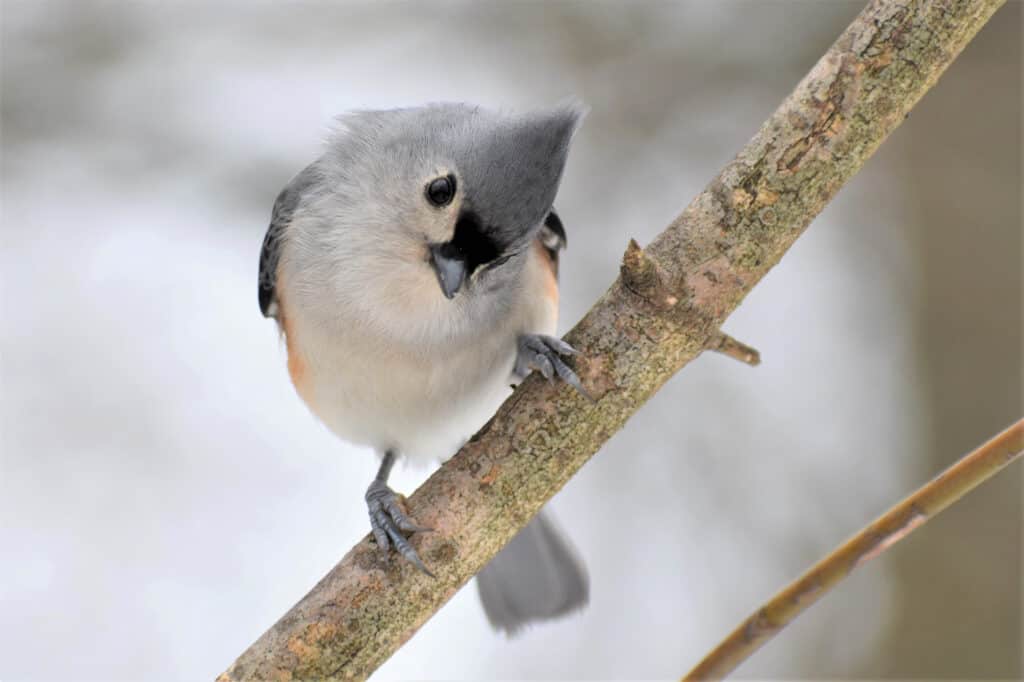
These birds love visiting backyard feeders for food and are regular visitors, especially in the winter!
©Lester Graham/Shutterstock.com
- Appearance and size: The tufted titmouse (Baeolophus bicolor) is a small songbird with white undersides, gray backs, rusty flanks, and large dark eyes. Females and males look alike.
- Habitat: Mixed wooded areas, leafy suburban backyards, old orchards and city parks
- Diet: Mostly insects and seeds, although in fall and winter, acorns are a mainstay of their diet.
- Status in Michigan: They are common birds in Michigan during both summer and winter and can be found in woodland and suburban areas throughout the state.
- Cool Fact: The tufted titmouse is known to regularly eat snow when there is no water available for drinking.
15. Mourning Dove
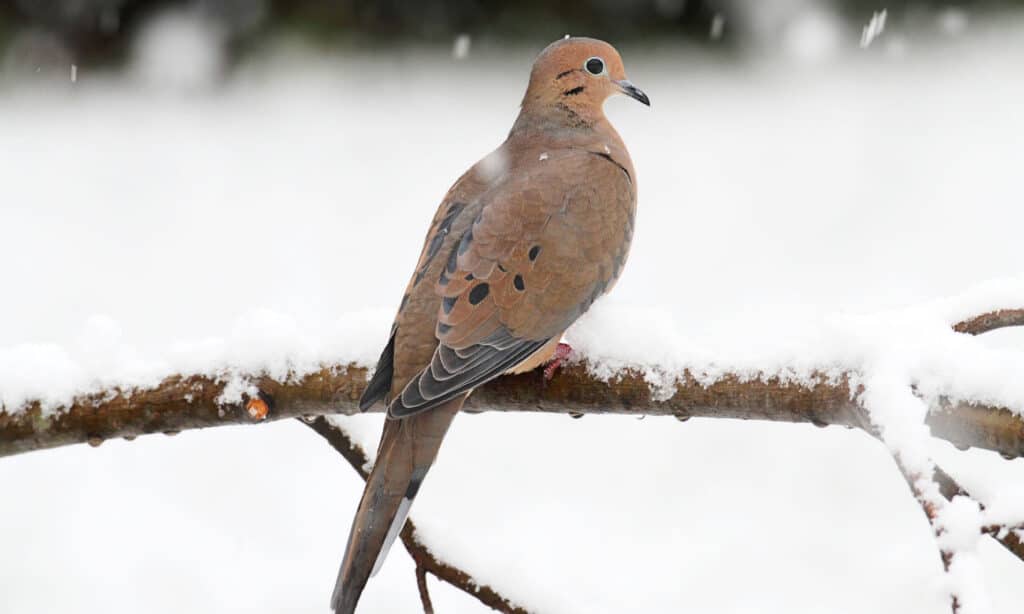
These graceful birds are known for their soft, distinctive call that often sounds like laments!
©iStock.com/SteveByland
- Appearance and size: The mourning dove (Zenaida macroura) is a medium-sized bird that weighs around 4.0-6.0 oz. It has a slender brown shape with a long tapered tail and a small round head and pink legs and feet. Adult males can show shades of pink, purple, and green on the sides of their necks and head. Females, though slightly smaller than males are similar in appearance but with more brown coloring overall.
- Habitat: Found in a variety of habitats but are most common in suburban areas and agricultural areas with shelterbelts and hedgerows.
- Diet: Grains and weed seeds.
- Status in Michigan: The state harbors a large, resident non-migrating population of mourning doves that are commonly found in suburban and agricultural areas and the parks of Michigan.
- Cool Fact: Mourning birds also known as ‘turtle doves’ can drink brackish spring water which typically has a lot of salt in it and still maintain a positive water balance, unlike humans who tend to get dehydrated.
16. White-Breasted Nuthatch

These birds are widely referred to as ‘upside down birds’ as they forage for food with their head positioned downwards!
©Jim Nelson/Shutterstock.com
- Appearance and size: The white-breasted nuthatch (Sitta carolinensis) is a small, thick-necked bird with a short tail and a stocky appearance. They have gray backs, white underparts, and a white face with beady black eyes. Male and female nuthatches are almost identical and the only difference is that, while males wear black caps, females wear a gray cap of feathers on their head.
- Habitat: Deciduous and coniferous woods, large parks, and leafy backyards.
- Diet: Insects and seeds
- Status in Michigan: They are common visitors in Michigan and are found throughout suburban areas and woodlands of the state. In winter, they are more common in the southeast regions of the state.
- Cool Fact: Female nuthatches rarely stray far from their mates and are known to stay in constant vocal contact when they are more than a few yards apart from each other.
17. Red-Breasted Nuthatch
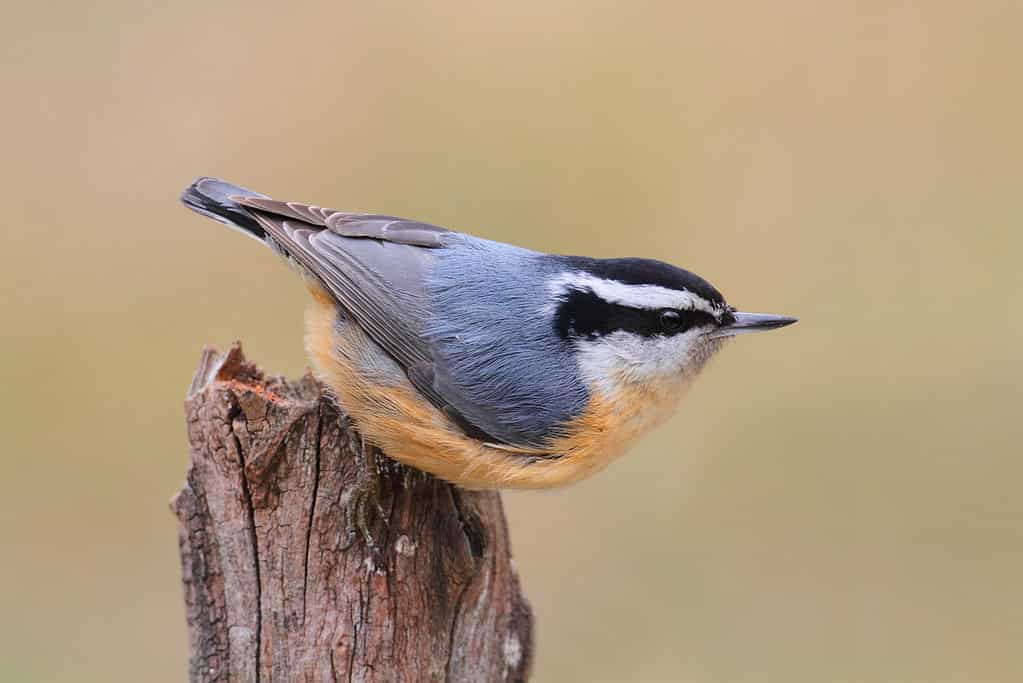
Red-breasted nuthatches are very chatty birds and super fun to watch!
©iStock.com/SteveByland
- Appearance and size: The red-breasted nuthatch (Sitta canadensis) is a tiny bird that is similar in appearance to white-breasted nuthatches. Their orange-brown breast and back is the only feature that sets them apart from these birds. Males have a black cap and a bright orange belly, while females wear a blue-gray cap and have a pale orange belly.
- Habitat: Northern coniferous forests and mountains and a variety of woodlands
- Diet: Primarily insects such as ants, caterpillars, spiders, flies, beetles, and conifer seeds outside of their breeding season.
- Status in Michigan: They are mostly found in coniferous forests in Michigan and live in the same area year-round
- Cool Fact: Red-breasted nuthatches can use their feet to climb trees, often allowing them to find food that other birds miss.
18. American Tree Sparrow
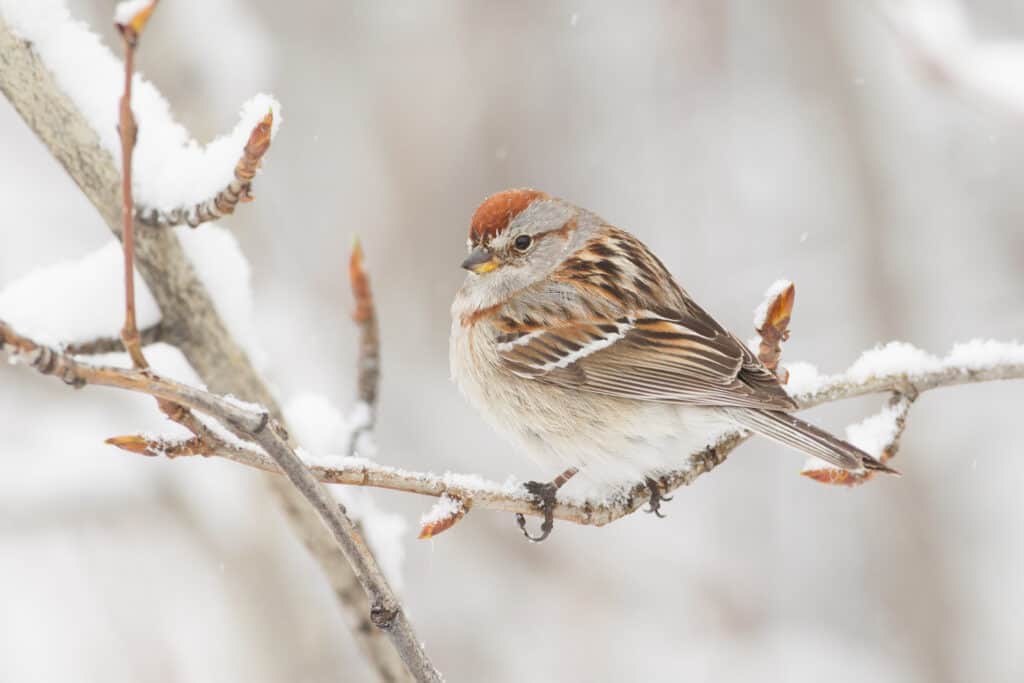
This rusty-colored bird is Michigan’s favorite harbinger of winter!
©Jukka Jantunen/Shutterstock.com
- Appearance and size: American tree sparrows (Spizelloides arborea) are small, round-headed birds with a gray face gray underparts, and a rusty crown on their head. Both male and female tree sparrows look alike.
- Habitat: Typically breeds near the northern tree lines in the summer and seek out weedy fields, hedgerows, open fields, and marshes during spring, fall, and winter.
- Diet: Feeds on seeds, berries, and insects, although changes in season can affect their dietary patterns a little.
- Status in Michigan: The American tree sparrows are frequent winter visitors and can be found throughout the state.
- Cool Fact: A recent study has found that American Tree Sparrows like to use their left eye to look out for predators.
19. American Crow
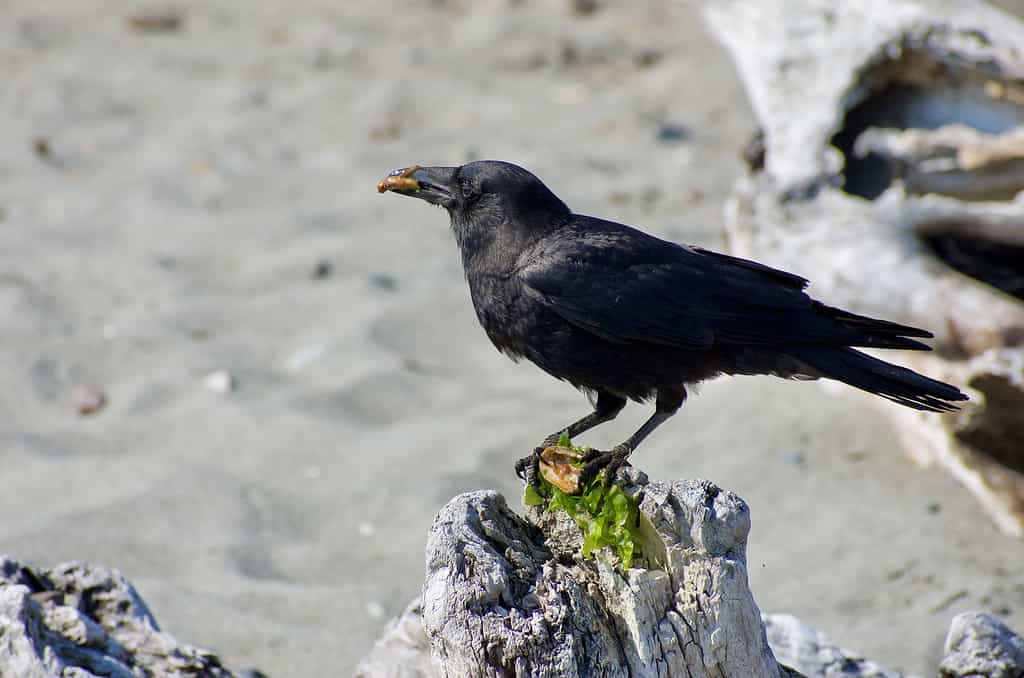
American crows are extremely smart and fascinating to watch!
©iStock.com/DanielLacy
- Appearance and size: The American crow (Corvus brachyrhynchos) is a glossy, all-black bird that is about 17 inches long. It has a long, thick bill and a short, squared tail.
- Habitat: Though commonly associated with agricultural areas, the American crow can be found in a variety of habitats including cities, suburbs, woodlands, and fields.
- Diet: American crows are omnivores and eat a vast array of foods ranging from berries, nuts, fruits, and seeds to small mammals, eggs, and human food.
- Status in Michigan: Common in Michigan and can be found in wooded areas, parks, and suburban areas of the state even in the winter.
- Cool Fact: American crows typically roost in large numbers ranging from hundreds to two million during the winter months.
20. House Sparrow

A male house sparrow with bright black, brown, and white color markings!
©iStock.com/Vronja_Photon
- Appearance and size: House sparrows (Passer domesticus) are small, chunky birds with gray heads, white cheeks, noticeably striped backs, and a black bib. Females are more muted with gray-brown markings on their underparts.
- Habitat: Common in urban, suburban, and rural areas as well as buildings, farms, and parks.
- Diet: Seeds, grains, insects, and human food scraps.
- Status in Michigan: House sparrows are widespread in Michigan and can be found in urban and suburban areas during the winter.
- Cool Fact: House sparrows love taking dust baths and frequently coat their feathers with soil and dust.
Summary of the 20 Common Birds That Spend Their Winters in Michigan
| Name of the Bird | Scientific Name | Status in Michigan |
|---|---|---|
| Red Crossbill | Loxia curvirostra | Resident Birds |
| Boreal Owl | Aegolius funereus | Migratory Birds |
| Snowy Owl | Bubo scandiacus | Migratory Birds |
| Horned Lark | Eremophila alpestris | Resident Birds |
| Snow Bunting | Plectrophenax nivalis | Migratory Birds |
| Dark-Eyed Junco | Junco hyemalis | Migratory Birds |
| Red-Bellied Woodpecker | Melanerpes carolinus | Resident Birds |
| Hairy Woodpecker | Dryobates villosus | Resident Birds |
| Downy Woodpecker | Picoides pubescens | Resident Birds |
| American Goldfinch | Spinus tristis | Resident Birds |
| Blue Jay | Cyanocitta cristata | Resident Birds |
| Black-Capped Chickadee | Poecile atricapillus | Resident Birds |
| Northern Cardinal | Cardinalis cardinalis | Resident Birds |
| Tufted Titmouse | Baeolophus bicolor | Resident Birds |
| Mourning Dove | Zenaida macroura | Resident Birds |
| White-Breasted Nuthatch | Sitta carolinensis | Migratory Birds |
| Red-Breasted Nuthatch | Sitta canadensis | Resident Birds |
| American Tree Sparrow | Spizelloides arborea | Migratory Birds |
| American Crow | Corvus brachyrhynchos | Resident Birds |
| House Sparrow | Passer domesticus | Resident Birds |
The photo featured at the top of this post is © Jim Cumming/Shutterstock.com
Thank you for reading! Have some feedback for us? Contact the AZ Animals editorial team.






